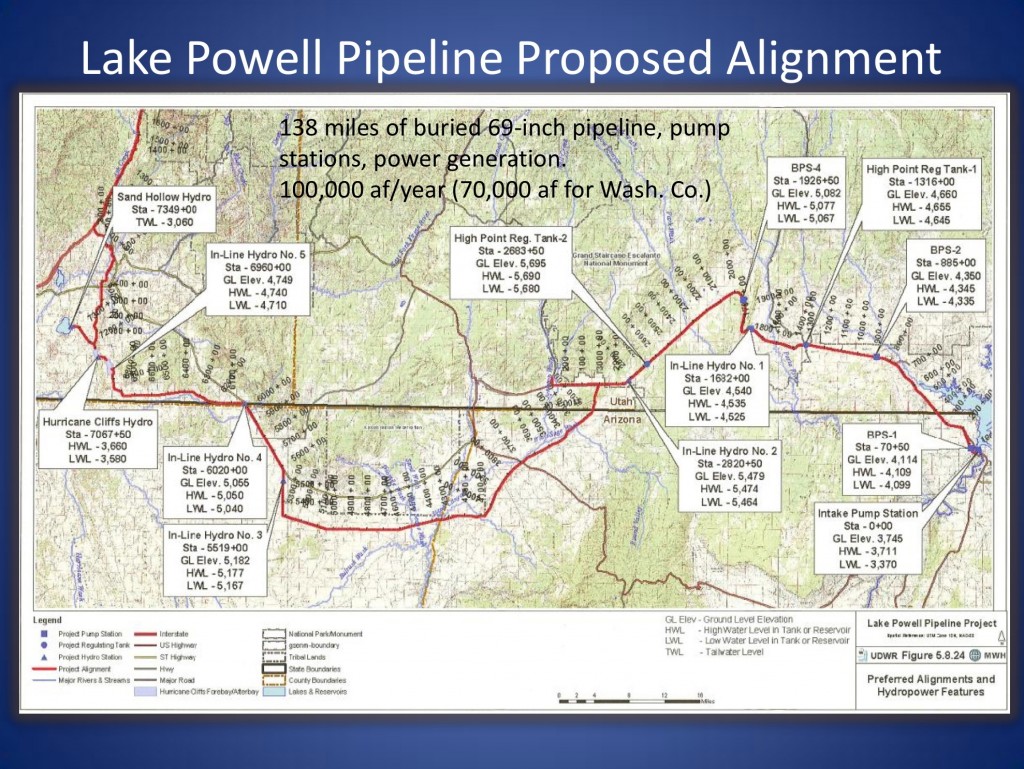High good, low bad: Mead in June 2011
Posted on | July 6, 2011 | 1 Comment

Source: Water Resource Planning in Washington County, Utah and the Lake Powell Pipeline, Presented at the Nevada Water Resource Association meeting February 3, 2011 by Corey Cram of the Washington County Water Conservancy District
Not only is this normally first-of-the-month post about Lake Mead late, it’s not even about Lake Mead. I find that the other great storage reservoir on the Colorado River, Lake Powell, was the more interesting of the big drinks in June. The Salt Lake Tribune found Utah’s Department of Water Resources taking state legislators for a plane ride over Utahn water ways. Whee.
Unlike leaner years, there was plenty of gleaming snowpack to sell any number of projects, not least the patently crazy proposal for a $1.1bn pipeline from Lake Powell into the snowbird communities of Washington County. That stretch of old Mormondom is to the south of the state, along the border of Nevada’s dry Lincoln County. This is where the Mojave Desert extends into Utah, a place called “Dixie” by the locals, where they only gamble, drink or smoke during trips to nearby Vegas.
Not long ago, a big business here was in ghost town tours. Now it’s in building retirement housing. The ultimate objective of the Lake Powell pipeline is to further populate the Mojave on the back of an already disastrously over-allocated Colorado River. Not all the local folks love the plan. I hadn’t heard of Citizens for Dixie’s Future until just landing on their website, but I like their catch phrases for the pipeline: “expensive,” “unreliable,” “unnecessary,” and “sprawling.”
Why would anyone tap the Colorado river more deeply when everyone agrees that it’s already crazily over-allocated? Because Utah is legally entitled to do it, and its developers are as greedy as our developers. Unlike our developers, they actually have legal claim to as yet un-used water. Unable traditionally to truck their water long distances, the “upper” Colorado River basin states such as Utah, Colorado, Wyoming and New Mexico have often been forced to see it released down stream for use by “lower” basin states of California, Nevada and Arizona, along with Mexico and, heavens forfend, fish. Phoenix, San Diego and LA all owe much to these surpluses. The Lake Powell pipeline would pull another 100,000 acre feet of water from the Colorado River, most of which would go to desert retirement communities such as St George.
If you’re wondering if more for them means less for us, the answer is yes.
The other Whoa, Nellie point, made almost en passant in the Tribune piece, refers to pending Utah legislation to buy sleeping Navajo rights for 81,500 acre-feet of Colorado River water. That is enough for 160,000 homes. Make that 80,000 in Utah, a state whose residents Vegas Water Manager Pat Mulroy rightly describes as being unable to spell “conservation.” This is fascinating because, again, the river is gaining abusive users while, for the most part, the amount of water in it is declining. Here, a product of brief surfing, is an article on the subject from the Navajo Times. Interested persons could spend a lot of time searching “water rights” at this newspaper. What all this means, I don’t know, other than less water in the river.
On that note, click here for the closing elevation of Lake Mead.
Tags: Emily Green > Lake Mead > Lake Powell Pipeline > Washington County Utah
Comments
One Response to “High good, low bad: Mead in June 2011”
Leave a Reply



July 7th, 2011 @ 1:01 pm
I like your blog and agree with much of what you wrote. One small correction: The proposed Lake Powell Pipeline is being pursued not to provide more population growth, but really to provide funding for a water project to employ its real constituency: the engineers and construction companies who would build it.
In other words, Washington County has plenty of water right. It is one of the most wasteful water using communities on the face of the planet. There is plenty of water there to satisfy future population growth. The shortage in Washington County isn’t about water, it’s about a shortage of good ideas for current and future water policies.
Utah is disinterested in real water conservation, that’s why the deadline for our water conservation goal (25%) is set way out in the year 2060. That equals a reduction of 0.5% per year in per capita water use.
Think about it this way. If your spouse told you he/she wanted to reduce credit card spending in your house by 0.5% per year, how seriously would you take them?